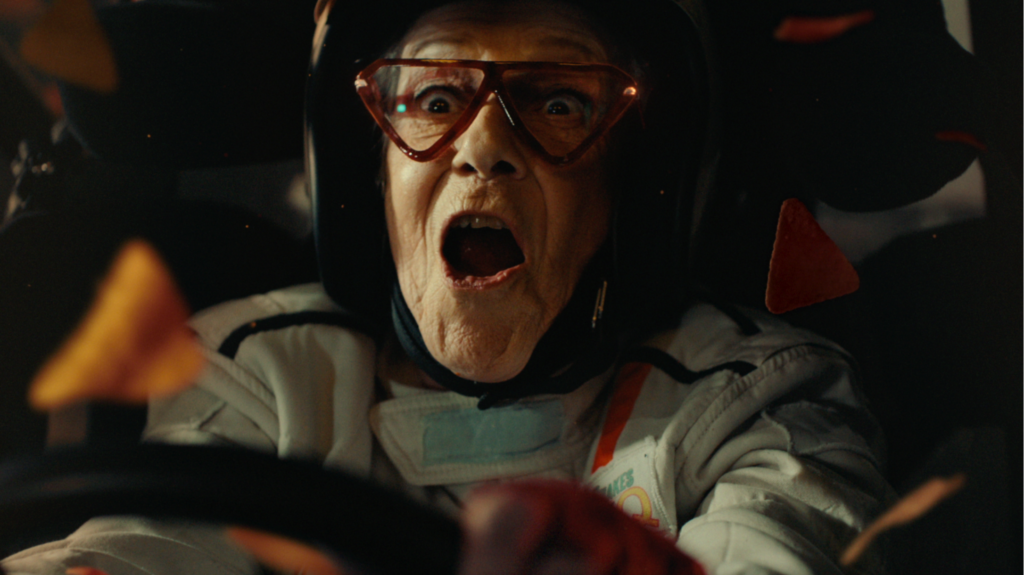
Doritos just launched its first international brand platform, “For the Bold in Everyone,” which champions self-expression, defying stereotypes and leaning into your passions. But this time, the target isn’t primarily Gen Z. The star of this creative is a grandma fulfilling her dream of driving a Monster Truck.
“There was an opportunity to make the brand more relevant beyond Gen Z,” said Fernando Kahane, Head of Global Marketing for Doritos. “There are a lot of consumers [aged] 60-plus who love Doritos, in multiple markets. And for a long time we hadn’t been talking with them. We were just talking to Gen Z.”
The campaign’s second goal is about leveraging the brand’s assets to connect with people and drive more meaning and relevance through storytelling. “How can we create a more cohesive brand, not only internationally, but also within the markets?” Kahane said. And that process has resulted in shifting from a demographic approach to targeting to an “attitudinal” one.
Below are the highlights of our conversation with Kahane, who delves into the brand’s segmentation strategy, how the campaign aims to drive local relevance, collaborating with creators, and more.
Chief Marketer: What’s different about this global campaign from Doritos?

Fernando Kahane, Head of Global Marketing at Doritos: We have had global platforms before, but we haven’t had a global campaign specifically designed for the asset to be implemented in multiple markets. We wanted to achieve a story that could be leveraged in multiple markets… and would resonate with different cultures, different people and in different market development stages as well. That’s the big difference. It’s not just a platform or an idea—it’s an execution that will be implemented in most markets and geographies.
CM: What’s the inspiration for this campaign, and why did this creative fit for a variety of international markets?
FK: There was an opportunity to make the brand more relevant beyond Gen Z… One of the big things about this campaign was to re-signify “bold” from stance and actions. You think about Doritos ads and you probably get people eating Doritos, and three Doritos later they are doing something crazy. We were trying to keep some essence of… this energy, but at the same time bring a bit more meaning and humanity to their stories [to make it] more widely relevant and resonate internationally.
The second thing is about distinction, and how we can create a more cohesive brand, not only internationally but also within the market. Because we didn’t have a clear-cut way [to tell] stories. Every market was creating different assets every year, and that was kind of disjointed. It was an opportunity to think about, what are the distinctive assets of the Doritos brand? How can we harness their power? For example, the word “bold” is a distinctive asset. People connect “bold” with Doritos ads. How can we make more of this distinctive asset or language and drive more meaning and relevance?
We started to run research to understand this, and although these stories were dissonant and not connected, there were things that were “a must” in all of these stories and were well-recognized by our consumers. We tried to create a framework internationally on how to use the stories that we tell… but also more consistency and hopefully stronger growth moving forward.

CM: How would you define your target market for this? Do you have specific goals with international markets?
FK: In terms of target, the main objective is, how can we attract not only the next generation of consumers, but a wider cohort group? And the key point is moving from demographic to attitudinal. There are a lot of consumers (aged) 60-plus who love Doritos, in multiple markets. And for a long time we hadn’t been talking with them. We were talking just to Gen Z. That’s a very important strategic move for the brand. We don’t segment anymore by demographic. We segment by people that are adventurous, like to express themselves, to try new things—like intensive snacks. It’s much more an attitude towards life and towards snacks rather than demographic. And from that, we have some nuances and assets, and create adaptations for the digital channels.
The importance of being distinctive and being consistent is about creating a brand that has a place in people’s mind, but also drive flexibility and autonomy to the local markets in a more organized way. We do have the global piece—the granny driving the Monster Truck. We have some other functional assets as well that were recorded with the same balance and the same directive. They’re going to be released throughout the year.
But the platform, the mission, is to make something distinct. We need to create something that allows the local markets to tap into and be more creative with it. The key local markets, such as UK, Australia, Netherlands and Mexico, are telling their own local stories of people’s passions, and breaking stereotypes in a bold, Doritos way. The global asset is going to be running in TV and digital, but we have local stories that are going to be running on social media, real stories that drive local relevance. It’s a balance between unity, but also understanding the importance of adapting to drive hyper-local relevance… It’s this flexibility within a framework.
CM: Beyond the commercial, how is the campaign being marketed to consumers?
FK: There are product stories that you haven’t seen yet, that we’re going to be releasing in two, three months’ time, about breaking stereotypes about product perception and the crunchiness of our product. And there are real stories. Every single market will be developing stories that follow the same thematic about “unstereotyping” through passion points in an entertaining way.
We started with the global campaign breaking an ageism stereotype. But we are going to break other ones, like toxic masculinity. We talk about age, but from a Gen Z perspective and those stereotypes. So there are a lot of passion points and groups working to create entertaining narratives that make people reflect about these stereotypes. It’s not pointing fingers. It’s more, “oh, I didn’t expect the grandma to drive. Oh, I didn’t expect that a blind person could be a skater.” (That is the UK story.) Gary Garcia, a boxer in Australia, likes to dress in a unisex way. And he’s also a ballet dancer. We start to uncover those stories that make people reflect about bias, but in an uplifting way.
CM: And how are you reaching consumers throughout the globe?
FK: It varies market by market, depending on the different channels and platform penetration. Some markets you have more TikTok penetration, some markets you have more Facebook, some markets you have YouTube, or even WhatsApp, in Brazil, for example. It’s quite adaptable. The one non-negotiable is the entertaining factor. It’s also why the real stories are an important component, because it’s not just us pushing out advertising, it’s about content creators developing their own stories for the world, and “sponsored by” Doritos.
This idea of push and pull, in terms of how we think about media and creativity, is a big next step for the brand. We are piloting it with this platform. But having clarity on the stories that we tell, we can empower creators and influencers to tell their stories, because we know what we stand for. That’s why a big brand idea matters, because otherwise you just get content out there and talk about your brand, but without that consistent narrative.
Editor’s Note: Here is part two of our coverage of Doritos’ brand campaign, in which Kahane discusses experiential marketing, the brand’s marketing mix and overall industry trends.




